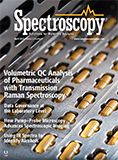Market Profile: Environmental and Food Applications Forging Growth for ICP and ICP-MS
Although weakness in the metals and mining industry has challenged the market for spectroscopy instruments in 2016, the demand for environmental and food testing have been robust, forging growth for key technologies such as ICP and ICP-MS.
Inductively coupled plasma (ICP) and ICP–mass spectrometry (ICP-MS) is mainly used for materials analysis applications for the determination of metals in the parts-per-billion and parts-per-trillion range, respectively. ICP and ICP-MS will work alongside with an atomic absorption (AA) spectrophotometer, where the ICP system has the advantage for delivering multielement analysis, and AA is preferred when fewer than 10 elements need to be analyzed.

Although weakness in the metals and mining industry has challenged the market for spectroscopy instruments in 2016, the demand for environmental and food testing has been robust, forging growth for key technologies such as ICP and ICP-MS. The Food and Agricultural Organization (FAO) and World Health Organization (WHO) continue to develop methods and standards to monitor toxic materials that could potentially enter the food chain through industrial pollution or environmental contamination. In particular, demand for ICP-MS has been strong fueled by testing of soil, rice products, apple juice, drinking water, and seafood, among other foods. ICP-MS can simultaneously determine trace levels of contaminants or toxins such as arsenic, cadmium, chromium, lead, and mercury. Rice and rice-based foods, for example, accumulate the highest level of arsenic among food crops. Rice is the staple of many Asian countries, and its consumption continues to rise in Africa and South America. ICP and ICP-MS accounts for 15% of the market for spectroscopy techniques used in environmental and food applications. The market is led by Agilent, PerkinElmer, and Thermo Fisher Scientific. Overall growth is forecasted to be strong over the next several years as laboratories continue to welcome new high-end instruments such as Agilent’s 8900 ICP-QQQ and Thermo Fisher Scientific’s iCAP TQ triple-quad ICP-MS systems into their research and testing facilities. Spectroscopy techniques, including mass spectrometry, molecular spectroscopy, and atomic spectroscopy, are important tools that help monitor the environment and ensure the safety of the world’s foods. Combined, these technologies represent nearly two billion dollars in instrument sales annually. Market size and growth estimates were adopted from TDA’s Industry Data, a database of market profiles from independent market research firm, Top-Down Analytics. For more information, contact Glenn Cudiamat, General Manager at (888) 953-5655 or glenn.cudiamat@tdaresearch.com. Glenn is a market research expert and has been covering the analytical instrumentation industry for nearly two decades.

Market Profile: Mass, Molecular, and Atomic Spectroscopy
December 1st 2018Mass spectrometry, molecular and atomic spectroscopy technologies combine to represent more than a fifth of the overall market for laboratory analytical instrumentation. These techniques are perhaps the most broadly used instruments, with utility in pharmaceuticals and other life sciences, chemicals, environmental, food, clinical/Dx and other applications.